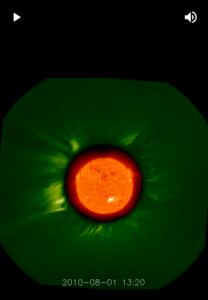
Our planet is constantly surrounded by cosmic phenomena, and while it may seem interesting, some can leave problematic situations in terms of our technological environment here on Earth that we depend on daily.
Solar flares are just one of the natural events that occur in space. This article will explore the connection between solar flares and their effects on Wi-Fi, software, and technology here on Earth.
Did you know the most recent solar flare was on August 7, 2023?
Here are a few facts:
- The Sun is quickly approaching a significant peak in solar activity.
- This peak will potentially begin by the end of 2023.
- Scientists state that this projection has come quicker than initial predictions suggested.
(LiveScience).
What Are Solar Flares?
Solar flares are intense bursts of energy as well as radiation from the Sun's surface. These instances are caused by the release of magnetic energy stored in the Sun's atmosphere. Solar flares can vary in size and intensity, with some being minor while others are enormous, unleashing a large amount of energy.
Press play to watch a video NASA recorded of a solar flare.
The Sun's influence on Earth extends far beyond providing light and heat. When solar flares are aimed in our direction, they can affect various aspects of our technology and communication systems. Here's how:
Impact on Satellite Communication:
Because solar flares release high-energy particles and intense radiation, they can interfere with the functioning of satellites that orbit Earth. These satellites are imperative for various applications, such as GPS navigation, weather forecasting, and telecommunications. A solar flare can also disrupt satellite signals, leading to communication blackouts and navigation errors.
Affecting Wi-Fi and Radio Waves:
Solar flares can also cause the Earth's ionosphere to be disturbed. This disturbance can lead to the absorption and reflection of radio waves, which are essential for Wi-Fi and terrestrial radio communications. During severe solar flares, radio signals can become distorted or even blocked, affecting our ability to communicate over long distances.
Power Grid Vulnerability:
Solar flares can also create magnetic storms interacting with the Earth's magnetosphere. (Space.com) These storms can create electrical currents within power lines and transformers, which can potentially damage electrical infrastructure. It is important to note that while modern power grids have safeguards in place, a strong solar storm could still pose a risk to the stability of the electrical supply.
Software and Data Corruption:
High-energy particles from solar flares can strike the Earth's atmosphere and interfere with electronic devices. This, interestingly, can lead to software glitches, data corruption, and even hardware damage. While most modern devices are shielded to some extent, extreme solar flares can still threaten sensitive equipment.
While there is no way to stop solar storms from occurring, scientists and engineers are constantly finding ways to mitigate these storms. This includes early warnings where NASA closely monitors the Sun, shielding radiation with satellites and backup systems for uninterrupted services.
Overall, while solar flares are interesting events that remind us of the Sun's power and influence on our planet, they still can disrupt various aspects of our technology-dependent society. As we continue to rely on technology in our daily lives, studying solar flares and their effects remains a crucial area of scientific inquiry and preparedness.





